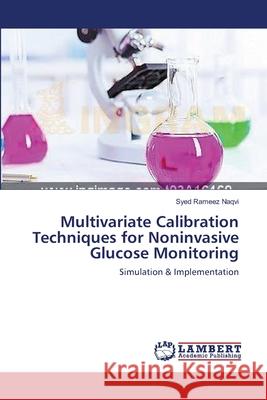Multivariate Calibration Techniques for Noninvasive Glucose Monitoring » książka
Multivariate Calibration Techniques for Noninvasive Glucose Monitoring
ISBN-13: 9783659543173 / Angielski / Miękka / 2014 / 88 str.
Multivariate Calibration Techniques for Noninvasive Glucose Monitoring
ISBN-13: 9783659543173 / Angielski / Miękka / 2014 / 88 str.
(netto: 170,37 VAT: 5%)
Najniższa cena z 30 dni: 178,89 zł
ok. 10-14 dni roboczych
Bez gwarancji dostawy przed świętami
Darmowa dostawa!
Diabetes is a rapidly growing disease that can cause several types of disabilities, and even death. No cure to this disease has been discovered as yet; the only solution is to monitor, and keep the level of glucose in blood controlled. Unlike the finger-prick method, non-invasive monitoring, through IR spectroscopy, is a convenient and harmless way of measuring the glucose level. In principle, a beam of light is focused on a part of body to excite the molecules, which either absorb this light partially or transmit some radiations in response. These radiations may be collected and unique response that different components of a blood serum show to this light may be observed in a form of spectra. Since glucose is not the only component present in blood, the multivariate calibration techniques are used to isolate the glucose spectrum from the collected spectra. This work presents a comparison between various multivariate calibration techniques in terms of their precision under varying signal-to-noise ratios. The presented results are useful, especially for the researchers working to develop a non-invasive glucose monitoring device, in making a choice between the available techniques.
Diabetes is a rapidly growing disease that can cause several types of disabilities, and even death. No cure to this disease has been discovered as yet; the only solution is to monitor, and keep the level of glucose in blood controlled. Unlike the finger-prick method, non-invasive monitoring, through IR spectroscopy, is a convenient and harmless way of measuring the glucose level. In principle, a beam of light is focused on a part of body to excite the molecules, which either absorb this light partially or transmit some radiations in response. These radiations may be collected and unique response that different components of a blood serum show to this light may be observed in a form of spectra. Since glucose is not the only component present in blood, the multivariate calibration techniques are used to isolate the glucose spectrum from the collected spectra. This work presents a comparison between various multivariate calibration techniques in terms of their precision under varying signal-to-noise ratios. The presented results are useful, especially for the researchers working to develop a non-invasive glucose monitoring device, in making a choice between the available techniques.











